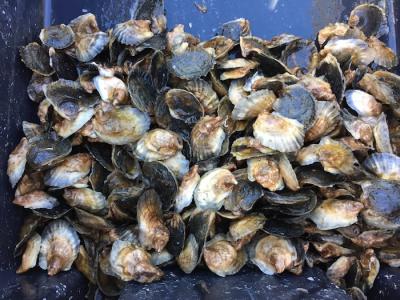Shellfish Hatchery Head Has High Hopes for 2018

The East Hampton Town Shellfish Hatchery disseminated about 40 million oysters, clams, and scallops into town waters last year, its director told the town trustees on Monday. The hatchery was established in the 1980s after a brown tide reduced the shellfish harvest by some 80 percent; in more recent years, it has made a hit with its oyster-gardening program, which gets the public involved in oyster growing and which, its director said, has great benefits for the marine environment of the creeks and ponds where the gardens grow.
In delivering his annual report to the trustees, who manage many town waterways and bottomlands on behalf of the public, Barley Dunne said that weather conditions had been generally favorable for growth and survival of the shellfish seeded in 2017. Periods of unusually warm water temperatures can be harmful to the shellfish habitat, but the water last summer, he said, had surpassed 80 degrees for just a few hours at a time, which was good news for the survival of the eelgrass that provides critical habitat for juvenile shellfish.
Mr. Dunne, who also delivered a report to the town board on March 20, said that hatchery staff grew 2.25 million oysters to 40 millimeters, the size at which they can be disseminated. “This year, the average size was something like 52 millimeters,” he said, with the larger size increasing the oysters’ odds of survival.
About 4.3 million clams were grown to a seed size of about 10 millimeters, Mr. Dunne said, and are overwintering in Northwest Creek. “We’re going to try to move them out of there early in the season and into more flowing water.”
The hatchery’s effort to grow and seed scallops was less successful, he reported. “Overwinter survival last year wasn’t very good. Coupled with our hatchery production, we didn’t have a great scallop year, unfortunately.”
In 2018, Mr. Dunne hopes to build on last year’s successes. “We’re going to shoot for a lot of the same numbers that we have achieved recently — more scallops, hopefully,” he said.
The oyster-garden program, started two years ago with 15 individual or family-operated plots in a designated area in Three Mile Harbor, is a hit. As reported in The Star’s March 15 issue, on March 12 the trustees reauthorized the program, which expanded to Hog Creek last year and will expand farther this year to Accabonac Harbor. The trustees also voted to double the size of the Three Mile Harbor garden, expanding the plot to 60 by 70 feet so it can accommodate up to 40 gardeners. The other sites will be 30 by 70 feet and available for up to 20 gardeners each.
Modeled on what is known as SPAT, a Cornell Cooperative Extension initiative in waters off Southold, the program allows individuals to harvest half of 1,000 oysters seeded. The cost, approximately $250 per participant, includes gear and instruction in addition to the oysters.
An increase in the numbers of shellfish in town waters, Mr. Dunne said, can have a broader positive effect on the environment: “Filtration is a huge factor in shellfish. They create habitat, they increase biodiversity.” An effort to seed Northwest Creek, years after its closure to the harvesting shellfish, paid off handsomely, he said. “We seeded it one day and came back a year later, and the oysters were huge, there was tons of macroalgae, and a lot of stuff you can’t even see, like grass shrimp, nursery finfish swimming around. It changed the landscape of the bottom for the better — tons of habitat, tons of filtration.”
The hatchery also raised about $60,000 last year, he said, through seed sales, fund-raisers, and the oyster-gardening project.
Meanwhile, the trustees are exploring an oyster-transfer program, in which the bivalves would be harvested from Oyster Pond in Montauk, the waters of which are uncertified (or closed to harvesting), and planted in one or more seasonally certified water bodies.
At the March 12 meeting, John Aldred of the trustees’ aquaculture committee said that the oyster-transfer program, intended to put a neglected resource to use by cleaning other degraded waterways, had been conducted in the 1990s, “until the oyster population gave out. It hasn’t been evaluated since then, as far as I know.”
The initial step, said Mr. Aldred, a former director of the hathery, would be a population survey of Oyster Pond, which is subject to park-use and survey permits from the New York State Office of Parks, Recreation, and Historic Preservation and the New York State Department of Environmental Conservation, respectively. “The first step would be to get in and see if there’s anything worth transplanting,” he told his colleagues. “As soon as we get these permits in place we will go into the pond with Barley . . . to see what’s down there, what condition it’s in.”
Should a sufficient number of oysters be found in the pond, the trustees would then seek a transplant permit from the D.E.C. and solicit participation of baymen to harvest oysters.
As the oysters would come out of uncertified waters, they would have to be transplanted in uncertified waters and live there for at least 30 days, Mr. Aldred said, before they could be harvested for consumption. “As long as they go into seasonally closed waters — uncertified for the season — they would then be open to harvest the following winter.”
Also on Monday, the trustees announced that Christopher Gobler, who has overseen water-quality testing of multiple water bodies for the trustees for several years, would deliver his annual report to the trustees at their meeting on April 23.
